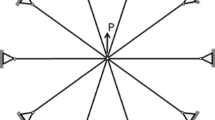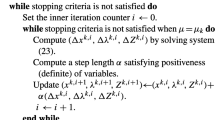Abstract
The problem of optimum truss topology design based on the ground structure approach is considered. It is known that any minimum weight truss design (computed subject to equilibrium of forces and stress constraints with the same yield stresses for tension and compression) is—up to a scaling—the same as a minimum compliance truss design (subject to static equilibrium and a weight constraint). This relation is generalized to the case when different properties of the bars for tension and for compression additionally are taken into account. This situation particularly covers the case when a structure is optimized which consists of rigid (heavy) elements for bars under compression, and of (light) elements which are hardly/not able to carry compression (e.g. ropes). Analogously to the case when tension and compression is handled equally, an equivalence is established and proved which relates minimum weight trusses to minimum compliance structures. It is shown how properties different for tension and compression pop up in a modified global stiffness matrix now depending on tension and compression. A numerical example is included which shows optimal truss designs for different scenarios, and which proves (once more) the big influence of bar properties (different for tension and for compression) on the optimal design.
Similar content being viewed by others
References
Achtziger, W. 1993a: Minimax compliance truss topology subject to multiple loadings. In: Bendsøe, M.P.; Mota Soares, C.A. (eds.)Topology optimization of structures, 43–54. Dordrecht: Kluwer
Achtziger, W. 1993b: Optimierung von einfach und mehrfach belasteten Stabwerken (in German).Bayreuther Math. Schriften 46
Achtziger, W.; Bendsøe, M.P.; Ben-Tal, A.; Zowe, J. 1992: Equivalent displacement based formulations for maximum strength truss topology design.Impact Comp. Sci. Eng. 4, 315–345
Cox, H.L. 1965:The design of structures for least weight. Oxford: Pergamon Press
Dorn, W.; Gomory, R.; Greenberg, M. 1964: Automatic design of optimal structures.J. de Mech. 3, 25–52
Hemp, W.S. 1973:Optimum structures. Oxford: Clarendon Press
Kirsch, U. 1989: Optimal topologies of structures.Appl. Mech. Rev. 42, 223–239
Michell, A.G.M. 1904: The limits of economy of material in frame-structures.Phil. Mag. 8, 589–597
Rockafellar, R.T. 1970:Convex analysis. Princeton: Princeton Univ. Press
Rozvany, G.I.N.; Bendsøe, M.P.; Kirsch, U. 1995: Layout optimization of structures.Appl. Mech. Rev. 48, 41–119
Rozvany, G.I.N.; Gollub, W. 1990: Michell layouts for various combinations of line supports, Part I.Int. J. Mech. Sci. 32, 1021–1043
Rozvany, G.I.N.; Wang, C.M. 1983: On plane Prager structures—I.Int. J. Mech. Sci. 25, 519–527
Svanberg, K. 1993: On the convexity and concavity of compliances.Struct. Optim. 7, 42–46
Taylor, J.E.; Rossow, M.P. 1977: Optimal truss design based on an algorithm using optimality criteria.Int. J. Solids Struct. 13, 913–923
Author information
Authors and Affiliations
Rights and permissions
About this article
Cite this article
Achtziger, W. Truss topology optimization including bar properties different for tension and compression. Structural Optimization 12, 63–74 (1996). https://doi.org/10.1007/BF01270445
Received:
Revised:
Issue Date:
DOI: https://doi.org/10.1007/BF01270445




